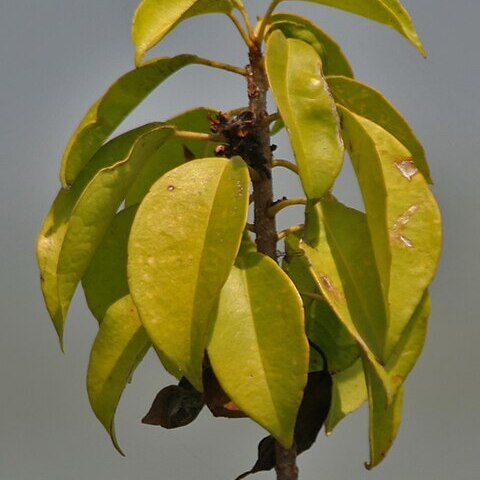Shrubs or trees, evergreen, perennial, monoecious; stems and foliage with copious white latex. Indumentum of simple, multicellular trichomes, glandular trichomes absent, stinging trichomes absent. Stipules entire, inconspicuous, deciduous. Leaves alternate, petiolate, elobate, penninerved, entire or crenate to serrate, glands at base of lamina. Inflorescences terminal or axillary, racemose or spicate, solitary or fascicled, unisexual with flowers in bracteate glomerules. Male flowers sessile to pedicellate; calyx lobes 2 or 3, imbricate, free and ± equal; petals absent; disc absent; stamens 2–8, filaments free and attached to a slightly raised receptacle; anthers basifixed, bilobate, thecae globose to oblong and longitudinally dehiscent; pistillodes absent. Female flowers pedicellate; calyx lobes 2 or 3 [E. dallachyana with 3 or 4 sepals; E. parvifolia with 4 sepals], imbricate, free or shortly connate; petals absent; disc absent; ovary 2-or 3-locular, ovules uniloculate; styles 2 or 3, free or united, simple. Fruit capsular, trilobate, smooth, dehiscing septicidally into 3 bivalved cocci. Seeds globose to ovoid; testa crustaceous; albumen fleshy; ecarunculate; cotyledons broad, flat.
Trees or shrubs, with milky juice, glabrous. Leaves alternate or opposite, petiolate; stipules small, caducous; leaf blade entire or serrulate, penninerved. Flowers unisexual (plants monoecious or dioecious), apetalous, without disk, in axillary or terminal racemelike thyrses. Male flowers (sub)sessile; sepals 3, small, imbricate, free; stamens 3; filaments free; anthers longitudinally dehiscent, without pistillode. Female flowers sessile to pedicellate; calyx 3-lobed or 3-partite; ovary 3-celled, smooth; ovules 1 per locule; stigmas extended or recurved, free to slightly connate at base, undivided, eglandular. Capsules dehiscent into 2-valved cocci; columella persistent, winged. Seeds globose, estrophiolate; episperm crustaceous; endosperm fleshy; cotyledon broad and flattened.
Male flowers small, ± sessile; sepals (2)3(4), ± free, imbricate; petals and disk absent; stamens 3 (African species), free, anthers extrorse, basifixed, 2-thecous, the thecae free at the base, longitudinally dehiscent; pistillode absent.
Inflorescences terminal or axillary, spicate or racemose, unisexual or bisexual with most of the inflorescence male with 1–5 female flowers at the base; bracts small, 2-glandular at the base, 1–8-flowered.
Female flowers small, shortly pedicellate; sepals ± as in the male flowers; petals and disk absent; ovary (2)3-locular, with 1 ovule per locule; styles (2)3, free or ± so, entire, strongly coiled.
Seeds globose or ovoid; testa crustaceous; caruncle separating from the seed and remaining adnate to the columella; albumen fleshy; cotyledons broad, flat.
Fruit (2)3-lobed, dehiscing into bivalved cocci; valves readily separating; exocarp smooth; endocarp thinly crustaceous; columella persistent.
Leaves alternate or opposite, petiolate, stipulate, simple, entire, crenulate or serrulate, penninerved, eglandular.
Dioecious or monoecious glabrous trees, shrubs or subshrubs.

